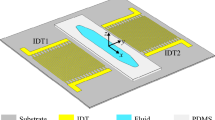Abstract
The filliform hairs of crickets are among the most sensitive flow sensing elements in nature. The high sensitivity of these hairs enables crickets in perceiving tiny air-movements which are only just distinguishable from noise. This forms our source of inspiration to design highly-sensitive array system made of artificial hair sensors for flow pattern observation i.e. flow camera. The realization of such high-sensitive hair sensor requires designs with low thermo-mechanical noise to match the detection-limit of crickets’ hairs. Here we investigate the damping factor in our artificial hair-sensor using different methods, as it is the source of the thermo-mechanical noise in MEMS structures. The theoretical analysis was verified with measurements in different conditions to estimate the damping factor. The results show that the damping factor of the artificial hair sensor as estimated in air is in the range of 10−12 N m/rad s−1, which translates into a 93 μm/s threshold airflow velocity.








Similar content being viewed by others
Notes
Etching holes effect will reduce the amount of damping due to the decrease in the effective area of the membrane and hence, the gas flow through these holes.
References
Andrews M, Harris I, Turner G (1993) A comparison of squeeze-film theory with measurements on a microstructure. Sens Actuators A36:79–87
Bao M, Yang H (2007) Squeeze film air damping in MEMS. Sens Actuators A Phys 3–27:136
Casas J, Steinmann T, Dangles O (2008) The aerodynamic signature of running spiders. PLoS One 3:2116
Dagamseh AMK (2013) From nature to MEMS: towards the detection-limit of crickets’ hair sensors. Smart Sens Actuators MEMS. doi:10.1117/12.2017329 [VI, 87632P, Grenoble, France, (May 17, 2013)]
Dagamseh AMK, Bruinink CM, Wiegerink RJ, Lammerink TSJ, Droogendijk H, Krijnen GJM (2013) Interfacing of differential-capacitive biomimetic hair flow-sensors for optimal sensitivity. J Micromech Microeng 23:035010. doi:10.1088/0960-1317/23/3/035010
de Bree H-E (1997) The microflown. PhD Thesis, University of Twente, Enschede, The Netherlands
Dijkstra M, Van Baar JJ, Wiegerink RJ, Lammerink TSJ, De Boer JH, Krijnen GJM (2005) Artificial sensory hairs based on the flow sensitive receptors hairs of crickets. J Microelectron Microeng 15:S132–S138
Fan Z, Chen J, Zou J, Bullen D, Liu C, Delcomyn F (2002) Design and fabrication of artificial lateral line flow sensors. J Microelectron Microeng 12:655–661
Gnatzy W, Heusslein R (1986) Digger wasps against crickets. I. Receptors involved in the antipredator strategies of the prey. Naturwissenschaften 73:212–215
Humphrey JAC, Devarakonda R, Iglesias I, Barth F (1993) Dynamics of arthropod filiform hairs. I. Mathematical modeling of the hair and air-motins. Phil Trans: Bio Sci 340:423–444
Kim ES, Cho YH, Kim MU (1999) Effect of holes and edges on the squeeze film damping of perforated micromechanical structures. IEEE Int Conf MEMS :296–301
Krijnen GJM, Lammerink TSJ, Wiegerink RJ, Casas J (2007) Cricket inspired flow-sensor arrays. In: Proceedings IEEE Sensors (Atlanta, USA), pp 539–546
Langlois WE (1962) Isothermal squeeze films. Quart Appl Math = cs XX(2):131–150
Magal C, Dangles O, Caparroy P, Casas J (2006) Hair canopy of cricket sensory system tuned to predator signals. J Theor Biol 241:459–466
Minikes A, Bucher I, Avivi G (2005) Damping of a micro-resonator torsion mirror in rarefied gas ambient. J Micromech Microengg 15:1762–1769
Nyguist H (1928) Thermal agitation of electric charge in conductors. Phys Rev 32:110–113
Ott HW (1976) Noise reduction techniques in electron systems. Wiley, New York
Pan F, Kubby J, Peeters E, Tran A, Mukherjee S (1998) Squeeze film damping effect on the dynamic response of a MEMS torsion mirror. J Micromech Microeng 8:200–208
Rocha LA, Mol L, Cretu E, Wolffenbuttel RF (2005) Experimental verification of squeezed-film damping models for MEMS. MME’2005 (Micromechanics Europe), Gotenburg, pp 4–6
Shimozawa T, Kumagai T, Baba Y (1998) Structural scaling and functional design of the cercal wind-receptor hairs of cricket. J Comp Physiol A183:171–186
Shimozawa T, Murakami J, Kumagai T (2003) Cricket and wind receptors: thermal noise for the highest sensitivity known. In: Barth FG, Humphry JAC, Secomb T (eds) Sensors and sensing in biology and engineering. Springer, Vienna, pp 145–57
Starr JB (1990) Squeeze film damping in solid state accelerometer. In: Tech. Digest, IEEE Solid State Sensor and Actuator Workshop, USA, June 1990, pp 44–47
Steeneken PG, Ruigrok J, Kang S, van Beek J, Bontemps J, Koning JJ (2007) Parameter extraction and support-loss in MEMS resonators. In: Proceedings of Comsol Conference 2007, Boston, MA, USA
Wang YH, Lee CY, Chiang CM (2007) A MEMS-based air flow sensor with a free-standing micro-cantilever structure. Sensors 7(10):2389–2401
Zou J, Chen J, Liu C (2001) Plastic deformation magnetic assembly (PDMA) of out-of-plane microstructures: technology and application. J Microelectromech Syst 10:302–309
Author information
Authors and Affiliations
Corresponding author
Rights and permissions
About this article
Cite this article
Dagamseh, A.M.K. Estimation of squeeze film damping in artificial hair-sensor towards the detection-limit of crickets’ hairs. Microsyst Technol 20, 963–970 (2014). https://doi.org/10.1007/s00542-014-2099-6
Received:
Accepted:
Published:
Issue Date:
DOI: https://doi.org/10.1007/s00542-014-2099-6




